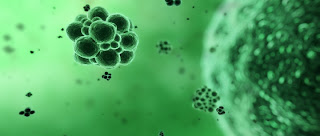 Assignment:
Assignment:
Come up with a setup for doing a Scanning Electron Microscope (SEM) look.
Observations:
When we think of images from a scanning electron microscope, what comes to mind is an image like that above: Typically black and white, pretty grainy, super close-up, and very alien looking. But let's look at some reference and dig a bit deeper.
Start with a reference material search. I almost always start with google's image search. Doing a search on SEM or "Scanning Electron Microscope" will give you a ton of stuff to look at.
I like the look of SEM bug pictures, so here's a pretty typical example:
Breakdown:
Overall look/feel: grayscale image; a single, simple subject against a black background; has an alien feel to it. There are color images out there, but the coloration is all post-process, paint-over, or color-wash.
Surface notes: grainy; very imperfect and bumpy; has an almost fractal look to the detail and structure; parts appear lit so that the surfaces facing the camera are dark while the glancing surfaces appear to grade to white.
Camera notes: cropped in tight which give the ultra-close-up look; has depth-of-field (aka DOF - blurry subject in foreground and background). The general reference search shows that not all SEM images show DOF, but I like the look so I'm going with it.
Lighting notes: The lighting is unusual given that the camera-facing surfaces are dark while the edges are white, but there is shadows and dark voids where we'd expect under normal lighting circumstances.
Initial thoughts/plan: Use this effect on a subject that makes sense in context (I'll go for ultra-simple in this example) -- taking an existing scene file with something like a house in it, or a logo, might not make sense (in other words, the image won't "sell" as being real) -- something more recognizable might work, but my thinking is that you'd want to be able to animate it so that you could establish the shot in a less recognizable, more believable context before revealing the more familiar subject. Technically/Feature-wise, I'm thinking we use falloff's to paint the surface, bump-maps for noise, render to encourage grain, use DOF, and simple lighting with some skylight to bring out those shadows in voids and around details.

images: top - Michael Spaw, spluttermite - unknown, greenpic - rustyshackelford


